Refugee Crises of the Twentieth Century Chronicled
Gale’s new product offers a vast collection of unique historical material from stalwart research institutions
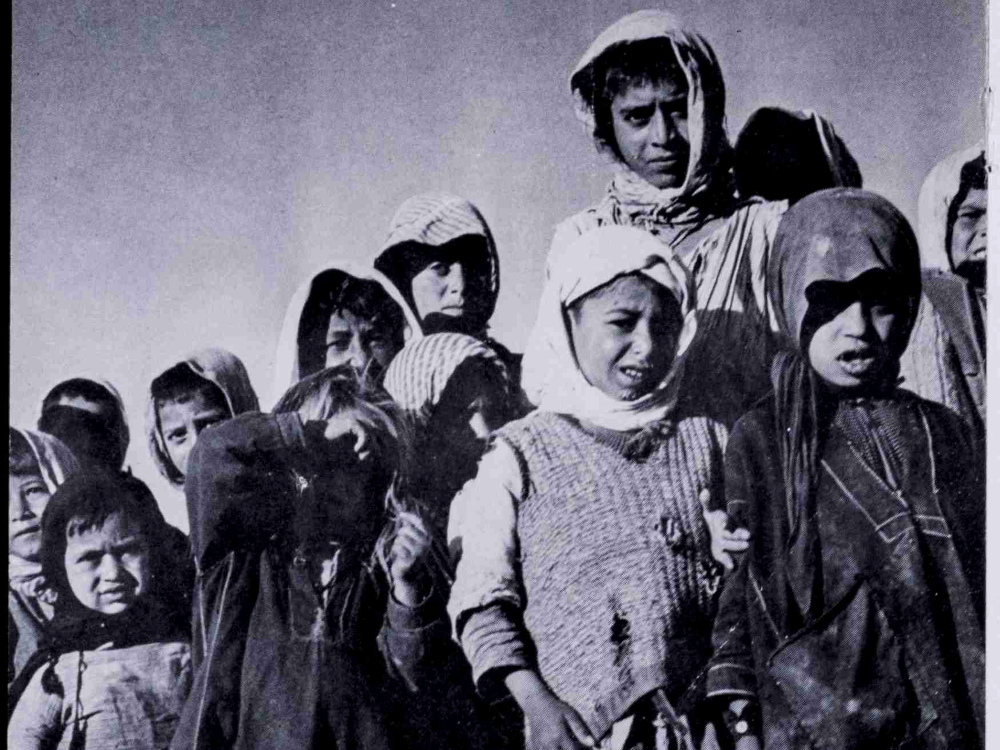
Gale’s new product offers a vast collection of unique historical material from stalwart research institutions
In the middle decades of the twentieth century, as Western allies and Communist regimes fought for influence in Africa, Asia, and Latin America, forced displacement and mass emigrations resulted in large-scale refugee flights and placements in refugee camps. Over the same period, the end of World War II and the start of the Cold War led to the decolonization of many European territories, with a number of former colonies forming new nation states. As these independence movements advanced, many competing tribes, ethnicities, religious factions, and other groups struggled for power. Conflict between fledgling nations over newly defined, sometimes fluctuating borders created further displacement and deepened the century’s refugee crises.
Gale’s Refugees, Relief and Resettlement: The Early Cold War and Decolonization (RRR) illuminates this history with over 400,000 pages of government files, refugee agency reports and archival material, legal briefs, pamphlets, relief organization publications, ephemera, and other types of primary sources. Given the interdisciplinary nature of migrant studies, this archive could be of value for researchers in a number of fields including history, border studies, political science, religion, immigration, law, global studies, and more.
RRR was published in March 2024, one of several Gale Primary Sources collections. The goal of RRR is to help researchers, students, and scholars better understand the historical context of our planet’s many refugee-related crises. RRR aims to elucidate the myriad challenges refugees have faced as well as the difficulties that have confronted governmental departments and relief agencies seeking to resettle or repatriate refugees.
The collection focuses on the period 1939–1987 and addresses the Hungarian Revolution; the Prague Spring; the Korean War and others in Southeast Asia; the Angolan Civil War; the British evacuation of India; the French-Algerian War; the India-Pakistan partition; the Indochina Wars; and the Israeli-Arab Wars, among other conflicts.
The materials on RRR’s platform have been collected and curated by editor Bennett Graff from a number of venerable institutions. The National Archives at Kew, UK, contributed refugee files and records from the Foreign Office and the Home and War Offices as well as additional refugee reports and records from the Foreign Office and the Offices of the United Kingdom. The National Archives of the United States provides records from the Department of State relating to refugees in Europe post-WWII, while the British Library provides refugee records from the British India Office. The World Jewish Relief, a British charitable foundation that was founded in 1933 to support German Jews suffering under Hitler’s rule, provides access to the archives of the Central British Fund for World Jewish Relief, which includes further access to additional collections from the National Archives (UK), the New York City Bar Association Library, and Rutgers University. Rutgers provides access to the American Council for Voluntary Agencies for Foreign Service collection, while materials from the New York City Bar Association Library include legal briefs from the US Federal Appeals Courts on Refugees and Asylum.
The scale and breadth of the collection, in addition to its international and interdisciplinary focus, make it particularly suited to upper level students, researchers, and scholars in history, economics, psychology, public health, sociology, anthropology, religion, immigration, literature and language, European studies, rights and immigration law, and global and area studies (particularly Africa, Asia, and the Middle East). I was particularly struck by governmental documents relating to Operation Babylift, an internationally led, large-scale evacuation of children from Southeast Asia to Western countries at the end of the Vietnam War; governmental pamphlets designed to help immigrants assimilate into new countries, like the 1949 “Guide for New Americans,” which was published in Yiddish and Polish; correspondence from refugees in Burma; legal briefs from the US Federal Appeals Courts that shed light on the United States’ Cold War era asylum policies; and materials from the Joint Press Reading Service that detail personal experiences of Hungarian displaced persons in Austria.
In an ideal world, this collection would contain more documents directly authored by refugees. Within the platform, Gale describes the difficulty refugees often faced in recording their experiences, including a lack of tools, resources, and safety. Gale also notes that some records and documents within RRR have been limited or redacted to protect the privacy of displaced people. Certain organizations and some of their records are inaccessible for legal and reputational reasons.
Browsers and operating systems that best support Gale’s electronic products include Chrome 75 with Windows 10, Chrome OS and Mac OS X 10.11, Firefox 70.0 with Windows 10, Safari 13.0 with Mac OS X 10.6–10.9, and Edge 44.17763 with Windows 10. On iOS phones (13+), the platform works best with mobile browsers like Safari, and on Android phones with Mobile Chrome. On other browsers or operating systems users may encounter issues with alignment, readability, navigation, and/or functionality.
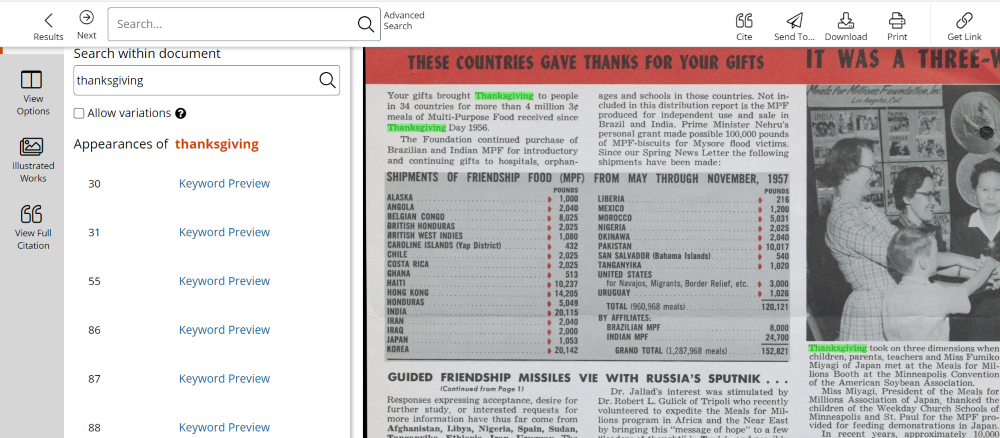

RRR looks similar to other Gale products, particularly those that fall under the Gale Primary Sources umbrella. The options and menus are typical of Gale, though there are some interesting additions, like a short series of accompanying essays, written by scholars, that provide context and discuss how they use primary sources in their work. “Research Examples” examine documents from within RRR, modeling for users ways they might work with primary sources. A section details how to use the Topic Finder as well as the Term Frequency Tool, both of which can help visual learners/researchers.
I had success searching for known items. My searches via Optical Character Recognition (OCR), where handwriting and the degraded condition of some documents present challenges, were inconsistent, though mostly good. For example, searching “Lake Tule” provided many accurate results, but still pulled one record that highlighted the term “title” instead of “Lake Tule.” Additionally, RRR includes downloadable transcripts for any documents that contain text.
Perhaps the most important and impressive aspect of the collection is the detailed metadata. In addition to title, author, language, document type, publication date, collection, and source library, RRR provides more specialized information like refugee population (the nationality, religious or ethnic background, or political affiliation of the refugee group described in the document), place of departure (the location where the refugees embarked or originated), place of destination (the location where the group of refugees was headed), and current location (the location of the refugee or group of refugees at the time the document was created).
In April of 2020, the Library Accessibility Alliance and the Big Ten Academic Alliance conducted a high-level accessibility review of the Gale Primary Sources platform alongside their testing partner, the digital accessibility company Deque Systems. The review identified several problems related to screen reader compatibility. In their April 2021 response, which is included on the Library Accessibility Alliance’s website, Gale detailed steps they’ve taken to address these issues.
Gale provides a general Voluntary Product Accessibility Template (VPAT) from August 2022 for the overarching Gale Primary Sources platform. Automated testing was done using Deque Systems’ AXE tool and manual testing using No-Visual Desktop Access screen reader software. Additionally, third-party testing by a non-sighted user was conducted using a variety of OS/browser/screen reader combinations. The VPAT details how Gale Primary Sources conform to the AA Level of Web Content Accessibility Guidelines (WCAG) 2.0 and 2.1 as well as Section 508 standards. Most of the areas where Gale Primary Sources did not conform were related to tables and headings in electronic primary source documents; the use of shape, size, and color to convey meaning; the document viewer not making proper announcement of a state change, like activating Zoom; OCR not being able to pick up non-text content types; and a lack of accompanying descriptive text.
Per the Platform Accessibility Policy available on its website, Gale achieved a 100% Gold rating in February 2024 from Text Box Digital’s ASPIRE platform, a verification service for accessibility statements. The Policy details Gale’s many accessibility features, like OCR, keyboard navigation, and PDF access, as well as employing ARIA (Accessibility for Rich Internet Applications) to enhance navigation, orientation, and labelling. The Policy also describes Gale’s history of testing platforms, and it specifies some exceptions, including that OCR text for Gale Primary Source archives is of variable quality and sometimes does not include structured metadata and tagging, that third party content and older files often lack alt text, that some third-party videos may lack transcripts, that the video player does not provide synchronization of transcripts, and that certain interactive features are not yet accessible to keyboard-only and screen reader users. Finally, the policy details a roadmap for future accessibility compliance work, with projects planned to improve navigation labels and status changes, standardize labels and headers, and more.
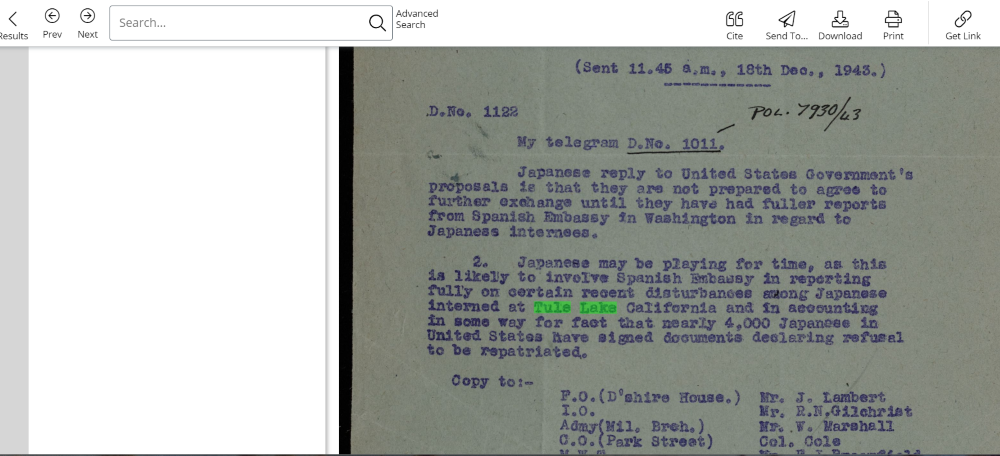
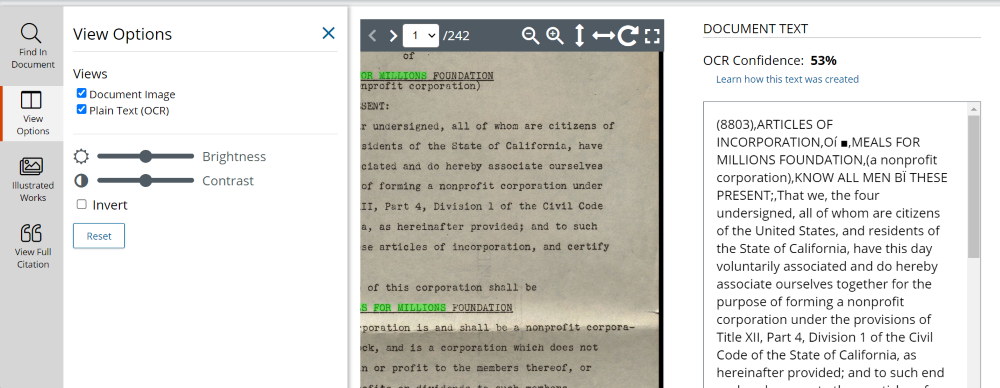
Gale provided a sample standard sales agreement contract from April 2024, which details the contract and purchasing provisions for RRR. Per the agreement for public libraries, “authorized users” include library staff, individual residents of the library’s reasonably defined geographic service area, and walk-in patrons accessing the materials on-site. For schools and academic libraries, “authorized users” include currently enrolled students, faculty, staff, and visiting scholars, as well as walk-in patrons accessing on-site. Additionally, the agreement prohibits the use of the platform to data mine, train AI, modify or scrape content, or perform competitive analysis, among other standard restrictions.
MARC records are available for download on the support page of Gale’s website. And RRR is offered with access to COUNTER-compliant usage statistics. A Gale representative would not provide exact pricing but did tell me that Gale Primary Source products employ six pricing tiers across the academic market with the lowest priced at 10 percent of the highest tier rate. Factors considered in pricing include each institution’s FTE, library budget, Carnegie Classification metrics, and graduate and doctorate level programs, as well as other metrics for individual institutions.
Access and authentication to Gale’s platforms is provided via IP authentication, and Gale works with EZ Proxy and Innovative Interfaces Proxy. Gale’s admin management tool allows library system administrators and support staff to authenticate users via IP address as well as control passwords and RPAS barcode authentication, view Shibboleth settings, apply referring URL patterns, and access cookie passwords.
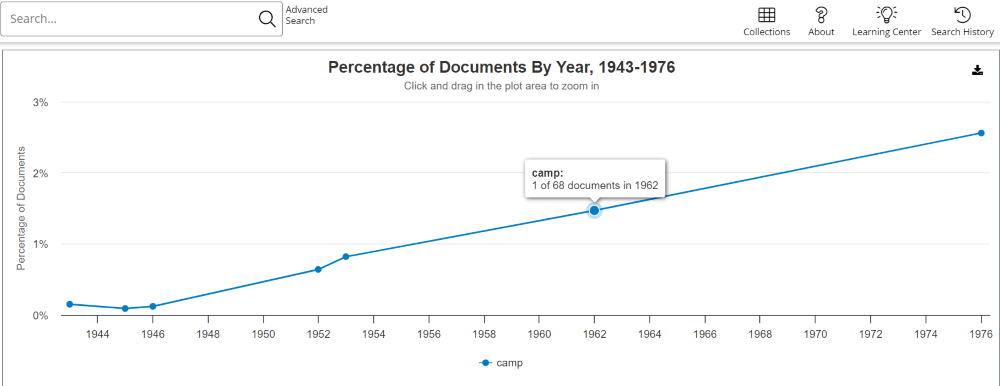
Gale offers a related resource titled Refugees, Relief and Resettlement: Forced Migration and World War II. The WWII product is obviously different from its sister collection in its topic and era coverage, with its documents ranging from 1933 to 1960, though it does pull materials from similar institutions. Another related product from Gale is titled Decolonization: Politics and Independence in Former Colonial and Commonwealth Territories. Compared to RRR, it has a greater emphasis on colonialism.
Adam Matthew Digital offers a couple of tangentially related products: Migration to New Worlds, which is more focused on immigration to the Americas and Australasia, and Empire Online, which is more focused on colonialism and imperialism rather than refugee crises and contexts.
Alexander Street Press’s Border and Migration Studies Online is likely the closest competitor to RRR. The product even pulls some material from one of the same institutions as RRR, the National Archives at Kew, UK, though there don’t appear to be any other overlapping contributors. Border and Migration Studies Online only has about 100,000 pages, which is a quarter of the amount RRR contains, and is focused on a much broader era including all of the nineteenth and twentieth centuries.
RRR is a robust collection of unique content that has been pulled from stalwart research institutions and organizations. One might wish for more documents directly written by refugees, but one can also understand how the complex contexts in which refugees exist limit the availability of such documents. Navigation through the resource is straightforward, and the bespoke limiters and metadata relating to refugee location, population, place of departure, and place of destination are valuable elements. The OCR is not perfect, which is to be expected to a certain degree when dealing with a vast collection of primary sources of different ages and conditions. Accessibility is largely well done, and Gale seems committed to continual improvements in this realm. More information about the price would be useful, but one can understand why Gale would want to make pricing institution specific.
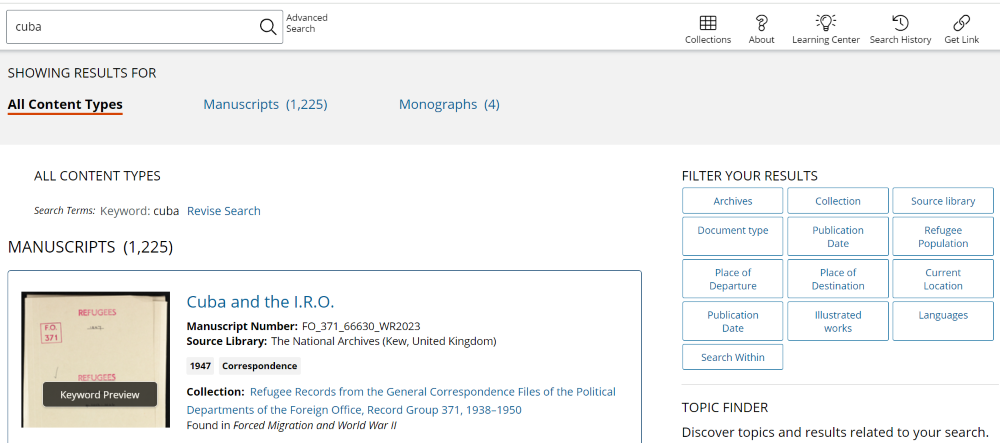
Overall, a very good resource. Given the inherently interdisciplinary nature of refugee studies, RRR could well serve a variety of academic populations, and its diverse content could facilitate collaboration across departments, studies, and researchers. I particularly recommend RRR for upper-level undergraduates, graduate students, and faculty or researchers who are working in programs that regularly engage with refugee studies.
Library Accessibility Alliance. (2020, April 14). Gale Primary Sources. https://www.libraryaccessibility.org/evaluation/gale-primary-sources
10.1146/katina-111824-1
Copyright © 2025 by the author(s).
This work is licensed under a Creative Commons Attribution Noncommerical 4.0 International License, which permits use, distribution, and reproduction in any medium for noncommercial purposes, provided the original author and source are credited. See credit lines of images or other third-party material in this article for license information.